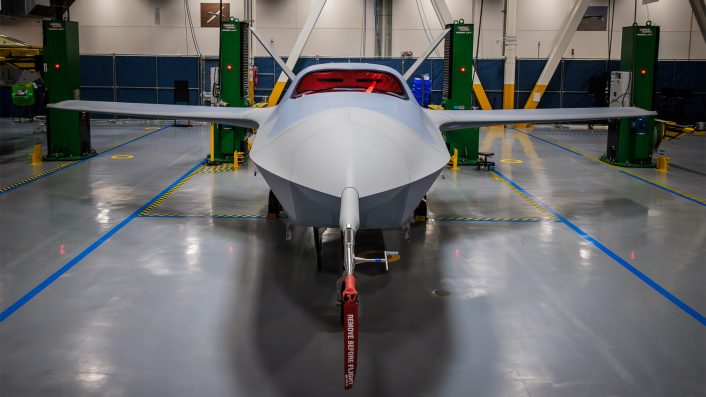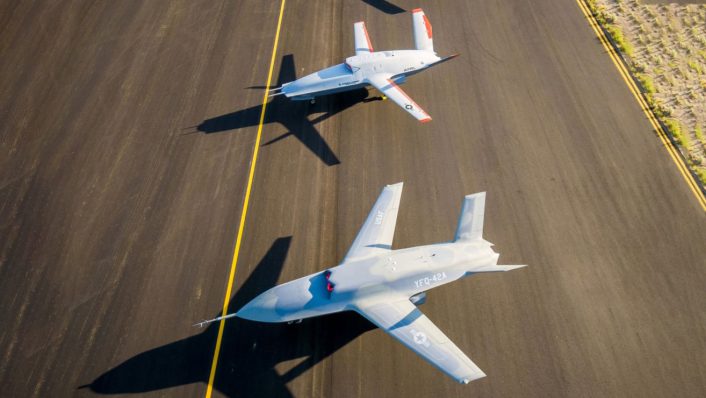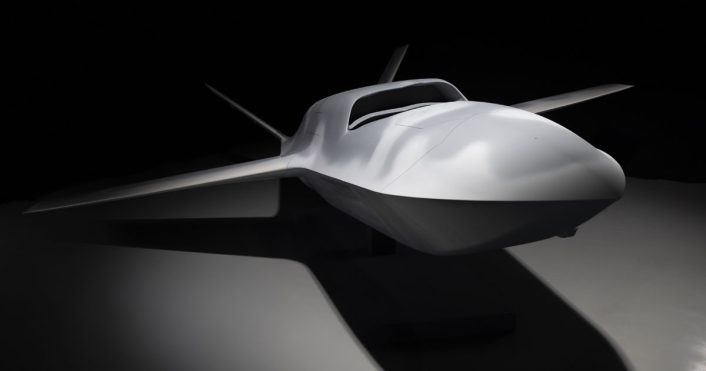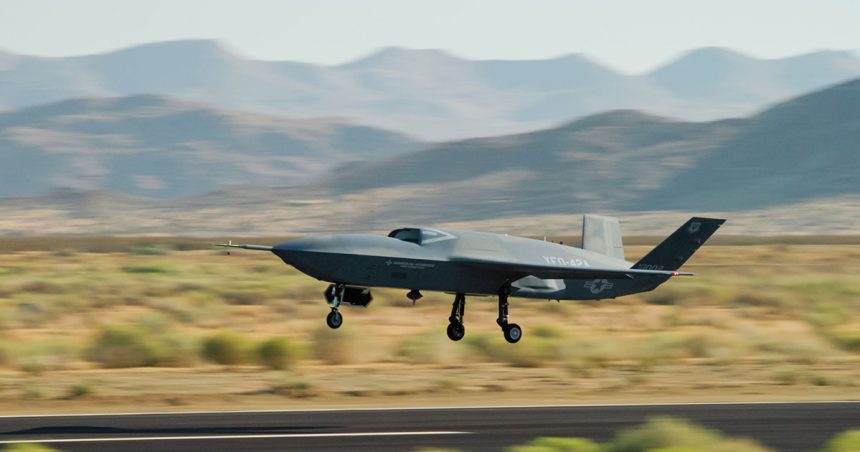The YFQ-42 becomes the first of the U.S. Air Force’s new Collaborative Combat Aircraft to enter flight testing.
General Atomics Aeronautical Systems has announced on Aug. 27, 2025, that its YFQ-42A Collaborative Combat Aircraft (CCA) has begun flight testing in coordination with the U.S. Air Force. The milestone marks the first flight of GA-ASI’s newest uncrewed jet, developed in just over a year and aimed at advancing the service’s CCA program.
“This is a great moment for the U.S. Air Force and for GA-ASI,” said David R. Alexander, the company’s president, in the official press release. “It’s been our collaboration that enabled us to build and fly the YFQ-42A in just over a year. It’s an incredible achievement, and I salute the Air Force for its vision and our team for delivering yet another historic first for our company.”
The YFQ-42 and Anduril’s YFQ-44 will be the U.S. Air Force’s first uncrewed fighters, selected for the Increment 1 of the CCA program. Both unmanned aircraft were expected to enter flight testing by the end of the summer.
CCA is in the air less than two years after the program began! Your @usairforce is moving FAST & learning FAST. CCA will help us rethink the battlespace, extend reach & optimize warfighter performance through human-machine teaming. @GenAtomics_ASI https://t.co/oGP8ZTW4oz pic.twitter.com/JJ0zlwuVbs
— General David Allvin (@OfficialCSAF) August 27, 2025
Ground testing for the YFQ-42A began in May, following the U.S. Air Force’s April 2024 decision to select GA-ASI to produce and fly a fully production-representative CCA. In March, the service officially designated the aircraft as YFQ-42A, with the “Y” indicating a production-representative test aircraft, “F” standing for fighter, and “Q” denoting an uncrewed platform.
The aircraft was unveiled for the first time at the start of the ground testing, although only a head-on photo was released. Until then, the aircraft was only shown in renderings and a mockup used during expositions.
However, in July, GA-ASI released a “family photo” of its jet-powered unmanned aircraft, which provide a new view of the YFQ-42.

The YFQ-42
The YFQ-42A is designed for semi-autonomous air-to-air operations and draws on the “genus-species” approach pioneered with the XQ-67A Off-Board Sensing Station (OBSS). GA-ASI says it leveraged advanced model-based digital engineering to accelerate the aircraft’s development while optimizing capabilities for future air dominance.
Compared to the XQ-67, the YFQ-42A features an engine air inlet with serrated edges, similar to the B-2 Spirit stealth bomber, as well as apparently slightly modified fuselage mold lines. The nose is also different, changing from the XQ-67’s ‘shovel’-like design to a more conventional one.
Differences can be seen in the wings’ design, with the YFQ-42 showing a higher sweep angle and a higher taper ratio, as well as a larger surface. The V-tails, although they have an angle similar to the XQ-67’s, appear to be shorter, with higher taper ratio and no clipped tips.

These design changes might be the result of attempts to reduce the airframe’s radar cross-section to match stealth requirements of the CCA program. Also, the modifications reflect the CCA’s requirements for speed and maneuverability.
Central to the program is the autonomy core that will make the YFQ-42 able to operate together with manned aircraft. The company says this core has been refined through more than five years of testing on the MQ-20 Avenger, which is also being used to test multiple autonomy agents for the Air Force.
By combining a stealthy, air-to-air-focused design with this AI-driven autonomy, the YFQ-42A is intended to provide warfighters with an advantage in future combat scenarios. Originally intended to complement the Next Generation Air Dominance manned fighter, the Boeing F-47, the CCAs will also fly with the current 5th gen platforms, the F-22 Raptor and the F-35 Lightning II.
GA-ASI emphasized that the program is designed around scalability and affordability. The company is preparing for high-rate production that would support the Air Force’s stated goal of fielding more than 1,000 CCAs on an accelerated timeline.

Collaborative Combat Aircraft
The development of the autonomous systems has advanced more rapidly than expected, leading some to suggest that NGAD’s crewed fighter might not be as essential as initially planned. The combination of CCAs with manned platforms like the F-35 and F-15EX could provide a more affordable and flexible solution to achieving air superiority.
The rise of CCAs reflects the Air Force’s shifting priorities, where a system-of-systems approach may take precedence over a singular focus on a high-cost manned fighter. The combination of manned and unmanned systems also allows for greater flexibility and the potential to deploy assets in more distributed and resilient ways.
The Air Force is rapidly advancing the development of CCAs, with plans to begin deploying over 150 units in the next five years. These autonomous systems could take on a range of missions, from surveillance to direct combat, working as force multipliers in collaboration with manned platforms and taking on high-risk missions traditionally performed by manned fighters.
Unlike legacy fighters, CCAs feature modular designs, enabling rapid upgrades and streamlined maintenance. The modular design and open architecture, the latter becoming a staple in the design of modern military aircraft, allows to introduce new capabilities as they become available, allowing in turn to always field the latest technologies to keep an edge over rapidly evolving battlefields.
In early 2024, Anduril Industries and General Atomics were awarded contracts to design and test production-ready CCAs, marking a pivotal step in the program. Both companies are developing these unmanned aircraft to support both the upcoming NGAD fighters, as well as current F-35s and other manned aircraft, by sharing sensor data, executing coordinated maneuvers, and potentially carrying out combat roles.

In early 2025, U.S. Air Force’s Chief of Staff, General David Allvin, announced the official designation of the first two CCAs. The two aircraft by General Atomics and Anduril have been named YFQ-42A and YFQ-44A, respectively, marking the first use of the ‘Unmanned Fighter’ designation by the USAF.
“We have two prototypes of Collaborative Combat Aircraft that were on paper less than a couple of years ago,” Allvin said. “For the first time in our history, we have a fighter designation in the YFQ-42 Alpha and the YFQ-44 Alpha – maybe just symbolic, but it’s telling the world that we are leaning into a new chapter of aerial warfare.”
The Air Force is planning to field a diverse fleet of over 1,000 CCAs, designed with modular configurations for weaponry, sensor capabilities, and rapid adaptability to mission needs. One notable advancement in 2024 was the first flight of the XQ-67A, a low-cost drone designed by General Atomics under the Off-Board Sensing Station (OBSS) program, which occurred in February 2024.
This platform, along with the earlier XQ-58A Valkyrie, demonstrates a “common chassis” concept—using shared components for various drone models to streamline production and reduce costs. This approach aims to provide a scalable, cost-effective solution for enhancing combat capacity without relying on high-cost crewed jets, which is essential given the Air Force’s budget constraints and strategic emphasis on distributed, resilient forces.
“A competitive Increment 1 production decision is expected in fiscal year 2026,” says the Air Force, “with development for Increment 2 beginning that same year to expand mission applications and integrate emerging technologies.”









